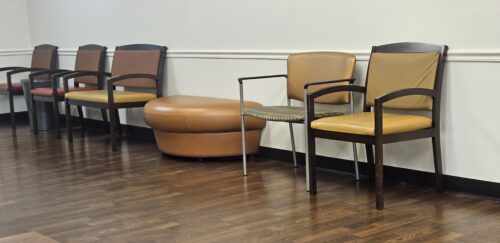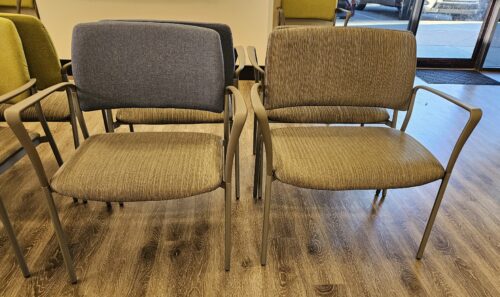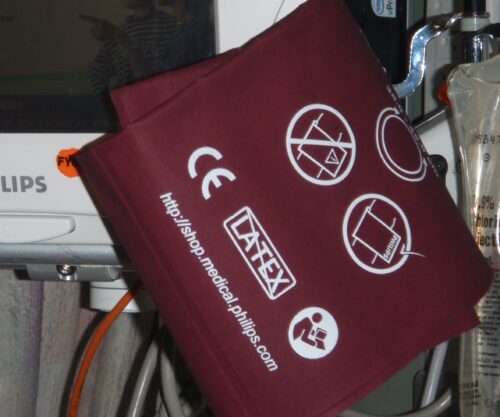While this can have an Endocrinology or Bariatric office slant, it should be for every office, medical or holistic or whenever there are guests in your office, please make accomodations for us.
I’ve been rabid about this topic for decades. I’ve written about it in my blogs and in newspaper articles and replied to comments. I have also talked to endless office managers and providers, explaining the needs of those of us who are not our ancestor’s size, but smaller sized (Class I) society-sized (Class II), larger-sized (Class III), even larger ( Class IV), and super-sized (Class V) like I was for 40 years.
When I had a Holistic Healthcare Office, I created a space for people up to 500 lbs. If I could do it out of IKEA and Costco furniture, medical offices can surely do it out of the amount of money they set aside for an office set-up.
Let’s go!

Chairs
The first thing we bigger folks do when we walk into a medical office of any kind is look at the chairs to see if our clinically obese butts will fit. It’s despairing to not find even one we might fit in. I speak up for myself, but most people do not. I will ask for a chair without arms and 90% of offices do not have even one in the space. Therefore, I ask the receptionist for her office chair because I can move the arms wider and the seats are always wider as well. I don’t ask as if it is a choice for them, but more a “please get up and give me your chair.” I am always polite, but firm. If there were chairs we could fit in, I wouldn’t have to interrupt the office with my need.
Clinically obese people can tell within seconds if the office is going to be (what I call) Fat-Friendly or not.
To reiterate, medical office waiting room chairs are too small for people with overweight or obesity. Often, way too small. I have been bruised many times, as have others even smaller than me. There is a way to avoid someone like me asking for someone else’s equipment.
Get some sturdy chairs with no arms.
Please order long, strong, and firm couches that are not low to the ground, preferably not soft like a comfy couch. It’s terribly humiliating to have to heave yourself up from a seat, especially in front of others in the waiting room.
Y’all are in the medical profession to help people, yes? It can start the moment we walk in the door.
Also, please make sure there is at least one chair in each exam room without arms. And not the exam stool… that’s an accident waiting to happen.
Scales
Of all things in a medical office, the scale makes me the craziest. Pardon the semi-rant.
Scales are responsible for more medical appointment cancellations than anything else. That’s not scientific, but is pretty anecdotal from people over about 200 lbs. and plenty under 200 as well. I wish I could express the despair people have knowing they are facing being weighed and that weight said out loud (I swear they use an invisible megaphone when saying the person’s weight.) and then it’s charted for posterity. I was the number one canceller over The Scale. But, I do know I am way not alone.
Before I get into the actual scale issue, I am going to beg two things from providers.
- Please, please weigh your patients backwards on the scale. ALL of them. “When you get on the scale, feel free to turn backwards.” That’s all that needs to be said. If they ask you to explain, tell them you understand many people do not want to see their weight and you want to honor that. Don’t just ask people over a certain weight, offer it to all of them. You can even ask, “Do you want to know your weight?” They have the right to say yes or no.
- Please consider taking the weight at the end of the visit. This alone will alleviate the worry that all you as the provider are thinking is that their weight is the root of their illness or reason for being there. Of course, if the weight is integral to the visit, that can’t be changed, but if you are in a field like Dermatology where weight isn’t the main issue, perhaps weighing at the end would be beneficial to the patient.
I fell over a balance scale in a hallway at an OB’s office when I weighed about 310 lbs. or so and broke my ankle, needing three surgeries to fix it. Yeah, I get the irony. Please move scales out of the hallway, and not just for safety’s sake, but for privacy’s sake.
Notice I said I was 310 lbs. I was not standing on the scale, but walking by on the way to a patient. I didn’t stand on the scale because balance scales back in the 1980s only went up to 300 lbs.
Right now, at my PCP’s office, my Hematologist/Oncologist’s office, my Cardiologist’s office, my Endocrinologist’s office, my Renal doctor’s office and my Nephrologist’s office, allllll the scales only go up to 300 lbs. The only way I know I weighed 405 lbs. April 22, 2022 was because I was in the ER before being admitted to the hospital. That means I could not weigh on any of my doctors’ scales until I had lost at least 105 lbs.
This is just wrong.
Anyone who deals with folks with clinical obesity simply must get scales that go up to, I feel, at least 500 lbs. Sure, they are expensive, but do you really want to help treat the disease of obesity and its inherent complications? Or are you paying lip service to it by refusing to get the most basic item necessary for our care?
Someone who weighs 600 lbs. isn’t going to want to go into your office to stand on a scale that goes up to 300 lbs. and watch the assistant push the balance up to 300 and say, “Ooops! It doesn’t go up that high!” This is something I have had happen more than a couple of times.
The best super-scale I stepped on was one like this at my Bariatric Surgeon’s office.
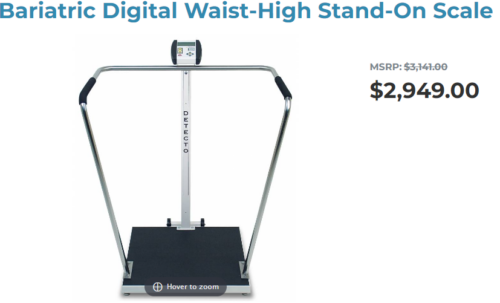
Blessedly, bathroom scales are now made for super-sized folks and I got one that weighed up to 400 lbs., but that wasn’t until I was already a year into losing weight. Amazon has bathroom scales that go up to 600 lbs. and are extra wide and safe to use. They are under $40. I found a couple of Smart Scales for the home at under $60 that go up to 550 lbs.
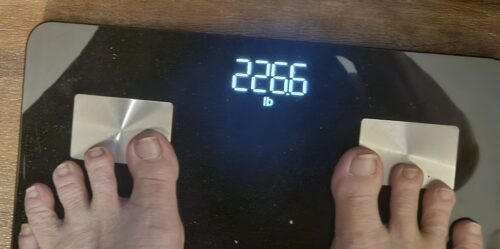
One last note.
The scale is terrifying for anyone over the weight they want to be, even more difficult if we are the weight we know puts us at risk for illnesses and diseases. The scale is what keeps so many of us from going to any doctor until it is a crisis and then it can be far worse than if we had come in sooner. The more you, the provider, can do to alleviate Scale-Phobia, the better for everyone, but especially for your patients.
Blood Pressure
When I was in my mid-300’s, the large cuff did not stay secure when the machine was ramping up. I needed a thigh cuff. I never saw a thigh cuff in a doctor’s office, only in the hospital and my midwifery office.
We are blessed with newer technology than an automatic BP Cuff.
Using an extra-large automatic wrist cuff is far easier on everyone.
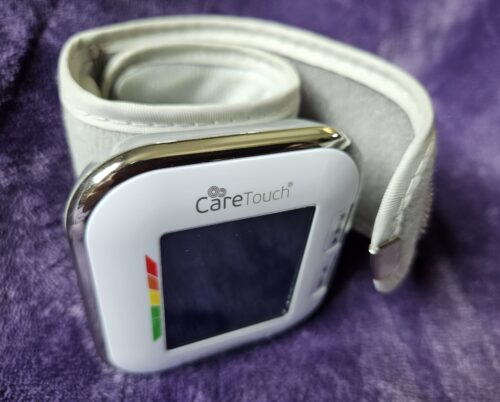
If all you have, until you buy a wrist cuff, is a standard automatic BP cuff, please, please teach staff to take the BP on the lower arm of anyone over 200 pounds. While the forearm measurement can be higher, if there is any question, then you can go to the upper arm. It is infinitely more comfortable for the person with lots of skin or fat folds on their arms to be measured on the forearm.
Labs & IVs
While we are on the arm issue, phlebotomists, please believe someone when they tell you where you will, and will not, be able to find a vein. I once was poked 6 freakin’ times in the CHEMO room before I said, “Goodbye for today. I am going home.”
And besides listening to your patient, if they say they are a hard poke, are crying before you even put the tourniquet on, please, oh pretty please, get the best person in the lab to do the blood draw. Remove your ego! “Oh, I can get it.” And you miss. Twice. Or more. And then get someone else? That is incredibly unfair to the patient. You poke holes in people’s skin all day long. It isn’t that big of a deal to you. But for us, it is incredibly traumatic to have our veins missed. It’s as if it is our fault they are hidden (“It’s because I am so fat!”) or roll or collapse. Please just get the best vampire you have there to do it.
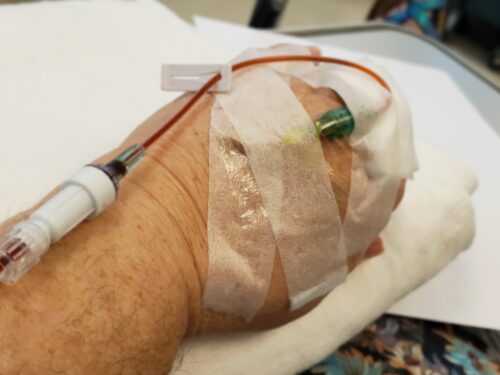
I ended up having an ER nurse, of her own volition, put “Call PICC Team for IV” in my chart. I have had the PICC and the Vascular Teams both put in my IVs with ultrasound with one poke. I think every lab or space that puts in IVs should have at least one person per shift trained to use an ultrasound to find accessible veins. Training and the equipment is expensive, but it’s archaic to just go by feel, especially in us hard pokes.
When you get the IV site going, please Tegaderm that sucker down so it doesn’t slip. Paper tape is worthless on people who sweat and it’s terrible watching the tape that was put on, peel off and have to ask someone secure the IV again. Tegaderm is the bomb.
When you have to use the tourniquet and make it tight as all get out, we know that is normal. Even when I am bruised badly from it being put on really tight, I don’t care. I would rather you see and/or feel the vein than not. You can even say, “I know this might hurt, but it will help us both in the end.” That alone soothes the pain of a bruise.
Please, please use butterfly needles on larger folks when drawing labs. Of course that is impossible with IVs. Yes, I know butterflies flow slower, but at least there is no guessing if you have hit the vein or not because you have flash. Flash helps me relax and let my breath out. I always say, “Please tell me when you get flash,” because I know we are one major step closer to the end of the lab draw. If you have a patient who wasn’t a care provider, you can say, “I got the vein.” The waiting to know sucks eggs. Any reassurance you can give is great!
Tips for Bringing Up Veins:
- Of course there is squeezing the fist. It’s far easier to squeeze a ball than a fist, especially with long fingernails.
- Have warm packs handy to lay on the site you are trying for. Sure, it slows down the lab flow, takes up a chair, and can be frustrating waiting, but to have a patient have the vein ready is far faster than poking them over and over again. And wastes a lot less inventory.
- I’ve often found a BP Cuff is a great tourniquet. Pump that sucker up high… again telling the person you know it is going to hurt, but it will help a lot, too.
I hope this helps soothe your patients. Getting labs drawn is a high anxiety time for most people, but to be the patient watching as techs miss the first two or three pokes, especially when they get frustrated, it’s really frightening. Let’s make that easier, okay?
Gowns
For the love of Pete, please, please order bariatric gowns. Even Amazon sells bariatric gowns that go up to 600 pounds. Get a couple of those, too. Clearly, you can see the string of embarrassing situations for a person with obesity with what I am sharing. Add to that the inability to put a gown on that might barely cover their leg. It can be even worse in hospitals and surgery centers when there is nothing appropriately fitting to wear.
Paper drapes suck as an alternative because so many of us who have obesity or overweight sweat. We sweat anyway, but with nerves added, it’s even more.. It’s just easier to buy bariatric gowns.

Exam Table
The first time I went to a practitioner that had an exam table with hydraulics, I cried with happiness. I was no longer terrified to get an exam on that table because I didn’t have to climb on it, or fear falling off as I was getting on it. I was also thrilled I didn’t have to get off the skinny table, too. Not only was the table made for much heavier folks, but it was also a boon for people with other mobility issues. These hydraulic tables are also typically made wider as well. Yay!
I know they are expensive, but if it brings more patients, it will make up for the cost. Heck, if I were in charge of advertising your clinic, I would use the table as an enticement to come to your office. They are a person with clinical obesity’s dream.
And please lay down a Chux for us to sit on on the table paper. I feel like every person sitting on that table naked deserves a Chux. There is nothing grosser than knowing other people’s body juices are underneath the wet paper lying on the table under your butt.
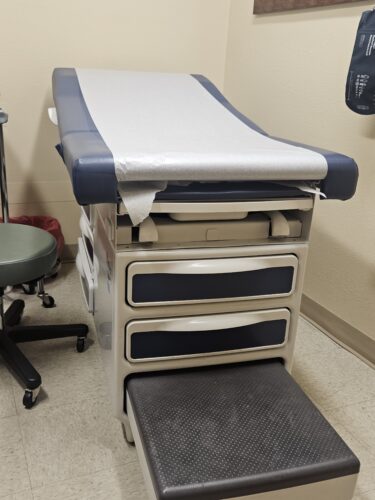
Notice the exam table above, how it is away from the wall. People who are super-sized struggle to keep their legs apart without leaning their leg on something. Another person can help with holding the knees up or, as I did, put my exam table up against the wall and only one person needed to hold the other knee so it didn’t drop inward, covering the genitals.

Equipment & Instruments
While we’re talking about the exam table, please remember that it isn’t uncommon for larger folks to need special equipment. Because I was a midwife, that equipment for me was speculums.
I used a Pederson XXL speculum, but another midwife-friend had a 4-Blade speculum that I used twice and loved. They are mega-expensive but very much worth it to own at least one in an OB/GYN practice that sees grand multiparas or women with severe clinical obesity.
When I’ve needed a Pap as a super-super-size woman, I now ask for referrals to a GYN because the two times I’ve allowed a PCP to do it, they screwed it up and hurt me all at the same time. I have vaginal walls that collapse and no matter how many times I asked if they had XXL specs, the answer was, “Oh, there won’t be a problem with large.” Once the spec was in, I would hear under their breath, “I can’t find the cervix.” Toldjaso. Then I was mad at myself for going ahead with something I knew was going to fail. My fault, not theirs.
Just like Bariatric Surgeons have gotten equipment that fits properly inside their super-sized patients, so should all providers do the same. The hospital has gotten larger and stronger gurneys, bigger gowns (not big enough for my taste and pre-GLP-1 body), stronger chairs, are making bathrooms in hospital rooms bigger, toilets stronger, the list goes on. If the hospital can do it, so can you.
“Does All This Special Attention Cater to Keeping People Fat?”
No. It meets people where they are.
While clinical obesity is not yet accepted in the American with Disabilities Act, you can tell I believe the time is overdue to include it.
We know now that being clinically obese is not anyone’s fault. You hear that fat-haters? There is actual clinical evidence that having obesity and overweight is a chronic disease.
Sure, our culture (pollution, food choices, water cleanliness, etc.) has a giant hand in many of our ailments, those with and without obesity. Whether someone has cancer from smoking or has been forever changed from a car accident while texting, blame has no place. Even if someone/many people do point their fingers in shame, it doesn’t change things. We are still going to treat and care for the people who might have had a hand in their situation. We will make allowances for them. We will show compassion.
It’s time to offer that same compassion to those who are clinically obese.



